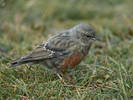search
classification
|
basic information
|
video
|
reports |
Alpine Accentor
Prunella collaris (Scopoli, 1769)

|
 adult
|
|
|
2018-09-14
Ala-Archa, Asai glacier, Ratsek hut |
© Oleg Belyalov
|
|
Description
Adult Alpine Accentor in breeding plumage have grayish-brown upperparts with dark-brown longitudinal streaks on back and rump. There is small rufous patch on shoulders. Chin and throat are off-white or white with black-brownish cross streaks, formed by terminal tips of each feather. Craw, middle-breast and belly are grayish-brown, breast-flanks and belly-flanks are rufous-brown. Undertail is brown with broad pale edges on each feather. Flight feathers are dark-brown; lesser upperwing coverts are grayish-brown; median and greater coverts of secondaries are black with white tips; greater coverts of secondaries and alula are black-brown with narrow white terminal edges. Tail feathers are dark-brown; inner webs of tail feathers (exclude central pair) have large white terminal spots. Legs are pinkish-yellow, claws are dark-brown. Upper mandible is dark-brown, low mandible is yellow dark tipped. Eyes are pale-brown. In fresh plumage after autumn moulting the upperparts have well expressed buffy tone; cross streaks on throat are larger. Juveniles are brownish-grey above, with not clear streaks on back; underparts are buffy-brownish with off-white bases of craw feathers. Flight feathers are dark-brown with narrow clay-rusty edges on outer webs; last secondaries have broad edges; last feathers have large white spots. Upperwing coverts as on adults. Sizes: males - wing 95-101; females - wing 91-96 mm. Weight: 25-35 gr.
Biology
Alpine Accentor is rare resident. It inhabits alpine belt of rocks; boulder fields near moraines and glaciers, down to upper shrub-belt; at 2800-4000 m in Tien Shan. In winter it occurs in rock with cliffs, and rarely in riparian forest, gardens and settlements at 1000-1500 m, singly or in small flocks of one-two dozen birds. Alpine Accentor breeds in separate pairs fairly far from each other. Birds come back to highlands in mid of March - early April. Nest is built in rocky cracks, small niches, between stones, or on ground under stone shelter; from moss and dry grass and lined with plenty of hair. Clutches of 4-6 eggs founded in mid of June - early July. Both parents feed juveniles, which fledge in July. Autumn movement begins between mid November and early December.
References
"Птицы Казахстана" том 4. "Наука". Алма-Ата, 1972. Э.И.Гаврилов. "Фауна и распространение птиц Казахстана". Алматы, 1999. Gavrilov E. I., Gavrilov A. E. "The Birds of Kazakhstan". Almaty, 2005.
unidentified birds
Анатолий Таран: Желтогрудый князёк
xxxx: плохо видно, но мне кажется это кулики либо песочники.
хххх: да. это крохаль, но скорее всего средний. длинноносый который. из за красной шеи. много лет не мог определить вид этой птицы. гугл мугл не помогад. [....]











